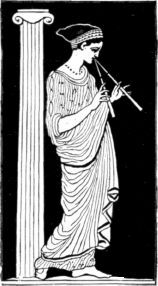MUSICAL INSTRUMENTS - online book
The History And Development Of Musical Instruments From The Earliest Times.
| Share page | Visit Us On FB |
|
32 MUSICAL INSTRUMENTS.
the instruments just noticed were used in Greece, chiefly by musicians who had immigrated from Asia; they can therefore hardly be considered as national musical instruments of the Greeks. The monochord had (as its name implies) only a single string, and was used in teaching singing and the laws of acoustics. The flute, aulos, of which there were many varieties, as shown in the woodcut p. 31, was a highly popular instrument, and differed in construction from the flutes and pipes of the ancient Egyptians. Instead of being blown through a hole at the side near the top it
was held like a flageolet, and a vibrating reed was inserted into the mouth-piece, so that it might be more properly described as a kind of oboe or clarionet. The Greeks were accustomed to designate by the name of au/os all wind instruments of the flute and oboe kind, some of which were coit structed like the flageolet or.like" our antiquated flute a bee. The single flute was called monaulos* and the double one diaulos. A diau/os, which was found in a tomb at Athens, is in the British museum. The wood of which it is made seems to be cedar, and the tubes are fifteen inches in length. Each tube has a separate mouth-piece and six finger-holes, five of which are at the upper side and one is underneath.
The syrinx, or Pandean pipe, had from three to nine tubes, but seven was the usual number. The straight trumpet, salpinx, and the curved horn, kcras, made of brass, were used exclusively in war. The small hand-drum, called tympanon, resembled in shape our tambourine, but was covered with parchment at the back as
 |
||